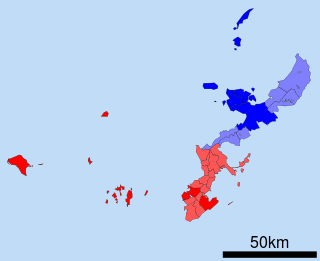
Back لغة أوكيناوا Arabic Idioma okinawense AST Okinawa Sproch BAR ཨོ་ཀི་ན་ལྦའི་སྐད། Tibetan Okinaweg Breton Llengua d'Okinawa Catalan Chṳ̆ng-sìng-ngṳ̄ CDO Okinawština Czech Okinava lingvo Esperanto Idioma okinawense Spanish
| Okinawan | |
|---|---|
| |
| Pronunciation | [ʔut͡ɕinaːɡut͡ɕi] |
| Native to | Japan |
| Region | Southern Okinawa Islands |
Native speakers | 1.2 million (2020)[1] |
Japonic
| |
| Language codes | |
| ISO 639-3 | ryu |
| Glottolog | cent2126 |
| ELP | South-Central Okinawan |
| Linguasphere |
|
 Northern Okinawan or Kunigami South–Central Okinawan or Shuri–Naha | |
 Okinawan is classified as Severely Endangered by the UNESCO Atlas of the World's Languages in Danger [3] | |
The Okinawan language (沖縄口, ウチナーグチ, Uchināguchi, [ʔut͡ɕinaːɡut͡ɕi]) or Central Okinawan is a Northern Ryukyuan language spoken primarily in the southern half of the island of Okinawa, as well as in the surrounding islands of Kerama, Kumejima, Tonaki, Aguni and a number of smaller peripheral islands.[4] Central Okinawan distinguishes itself from the speech of Northern Okinawa, which is classified independently as the Kunigami language. Both languages are listed by UNESCO as endangered.[5]
Though Okinawan encompasses a number of local dialects,[6] the Shuri–Naha variant is generally recognized as the de facto standard,[7] as it had been used as the official language of the Ryukyu Kingdom[8] since the reign of King Shō Shin (1477–1526). Moreover, as the former capital of Shuri was built around the royal palace, the language used by the royal court became the regional and literary standard,[8][7] which thus flourished in songs and poems written during that era.
Today, most Okinawans speak Okinawan Japanese, although a number of people still speak the Okinawan language, most often the elderly. Within Japan, Okinawan is often not seen as a language unto itself but is referred to as the Okinawan dialect (沖縄方言, Okinawa hōgen) or more specifically the Central and Southern Okinawan dialects (沖縄中南部諸方言, Okinawa Chūnanbu Sho hōgen). Okinawan speakers are undergoing language shift as they switch to Japanese, since language use in Okinawa today is far from stable. Okinawans are assimilating and accenting standard Japanese due to the similarity of the two languages, the standardized and centralized education system, the media, business and social contact with mainlanders and previous attempts from Japan to suppress the native languages.[9] Okinawan is still kept alive in popular music, tourist shows and in theaters featuring a local drama called uchinā shibai, which depict local customs and manners.[10]
- ^ Okinawan at Ethnologue (27th ed., 2024)

- ^ 45-CAC-ai comprises most of Central Okinawa, including Shuri (Naha), Ginowan and Nishihara; 45-CAC-aj comprises the southern tip of Okinawa Island, including Itoman, Mabuni and Takamine; 45-CAC-ak encompasses the region west of Okinawa Island, including the Kerama Islands, Kumejima and Aguni
- ^ "Central Okinawan in Japan | UNESCO WAL".
- ^ Lewis 2009.
- ^ Moseley 2010.
- ^ Kerr 2000, p. xvii.
- ^ a b Brown & Ogilvie 2008, p. 908.
- ^ a b Kaplan 2008, p. 130.
- ^ Noguchi 2001, p. 87.
- ^ Noguchi 2001, p. 76.